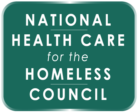Health center program grantees know the catchphrase, “housing is a social determinant of health,” and many have begun to try to assess and address patients’ housing challenges in order to improve health outcomes. A critical tool available to health centers lies ‘outside the four walls’ of the health center in local homeless coordinated entry systems1, which provide for a more centralized and coordinated approach to a community’s homeless crisis response system. In short, coordinated entry systems are meant to streamline access to housing options for homeless and at-risk individuals and families in a given geographic region. Health centers serving homeless patients (1,159 health centers served 1,191,772 individuals experiencing homelessness in 2015)2 are ideal partners for coordinated entry systems. This brief will provide information for health center program grantees on what coordinated entry is meant to be, how and why to partner with these systems, and will demonstrate both methods and effectiveness of this effort through case examples from the field.
Health Centers and Coordinated Entry: How and Why to Engage with Local Homeless Systems
Categories:
Best Practices, Clinical Practice, Homeless Services, Permanent Supportive Housing

